
Aloe massawana Photo by: Forest Starr & Kim Starr
Flowering habit at Honokanaia, Kahoolawe, Hawaii (USA). December 18, 2012.
Origin and Habitat: Southern Kenya and northern Tanzania as far south as Dar es Salaam and on a small island near Zanzibar, according to Reynolds also from Mozambique and Eritrea. Aloe massawanaSN|29242]]SN|29242]] is the only mainland African species also occurring on Madagascar. However, Southern Kenya and northern Tanzania as far south as Dar es Salaam and on a small island near Zanzibar, according to Reynolds also from Mozambique and Eritrea. Aloe massawanaSN|29242]]SN|29242]] is the only mainland African species also occurring on Madagascar. However, A. massawana was most probably introduced, as suggested by Castilon (Carter in Litt. 21.02.2012).
Type locality: Tanzania, Uzaramo District, 33.5 km. N. of Dar es Salaam, Ukutani.
Altitude range: 0-20 metres above sea level.
Habitat and Ecology: Aloe massawanaSN|29242]]SN|29242]] grows right on the beach front in the salt spray zone on coral outcrops. Also recorded in sandy soils, in grass and open thickets near the sea shore. It is not very common. The extent of occurrence and area of occupancy are small enough for a Vulnerable listing; it is known from only five locations which are severely fragmented and there is continuing decline due to human activities along the coast. Has attractive flowers so would also be sought by succulent collectors. was most probably introduced, as suggested by Castilon (Carter in Litt. 21.02.2012).
Type locality: Tanzania, Uzaramo District, 33.5 km. N. of Dar es Salaam, Ukutani.
Altitude range: 0-20 metres above sea level.
Habitat and Ecology: Aloe massawanaSN|29242]]SN|29242]] grows right on the beach front in the salt spray zone on coral outcrops. Also recorded in sandy soils, in grass and open thickets near the sea shore. It is not very common. The extent of occurrence and area of occupancy are small enough for a Vulnerable listing; it is known from only five locations which are severely fragmented and there is continuing decline due to human activities along the coast. Has attractive flowers so would also be sought by succulent collectors.
Synonyms:
See all synonyms of Aloe massawana
back
Accepted name in llifle Database:Aloe massawana ReynoldsJ. S. African Bot. 25: 207 (1959) [= p.p. A. eumassawana S.Carter & M.G.Gilbert, quoad Reynolds 8047 et fig. 154]Accepted name in llifle Database:Aloe massawana subs. sakoankenke (J.-B.Castillon) J.-B.CastillonInt. Cact. Advent. 83: 27. 2009 [Jul 2009] nom. inval. without basionym pageSynonymy: 2
back
Description: Aloe massawana is a decumbent succulent herb, stemless or short stemmed, solitary or suckering to form dense groups up to 3 meters in diameter. The leaves are held in a compact rosette, erect then spreading and slightly recurved. It is often mistaken for Aloe vera due to the similarities of their leaf traits. Comprises 2 subspecies: subsp. massawana and subsp. sakoankeke.
Derivation of specific name: The species, "massawana", derives from an old locality name, Massawa, in Eritrea.
Leaves: About 16 in a compact rosette, erect then spreading and slightly recurved; lamina lanceolate-attenuate, 50-90 cm long, 6-10 cm wide at the base, bright or dull green, sparsely white-spotted near the base when young. Margin with pungent, soft to firm deltoid teeth, white minutely brown-tipped, (1.5)2-3(-5) mm. long, 15-25 mm apart.
Inflorescence:* Erect, (60-)120-200(-230) cm tall, with 2-3(-7) erect branches, rarely simple. Racemes cylindrical, 15-20(-35) cm long, and 5 cm wide, fairly densely flowered, the youngest buds enveloped by the bracts, with a few sterile bracts below each raceme. Bracts ovate- deltoid, acute, 5-7 mm long and 3-4 mm wide, pale buff-coloured. Pedicels 5-7 mm long.
Flowers: Perianth bright scarlet, pale red or dusty pink, pale yellow to whitish towards the mouth, cylindric-trigonous, rounded at the base, slightly narrowed above and slightly expanding towards the mouth, 26-32 mm long, 7 mm in diameter across the ovary. Outer segments free to nearly halfway, about 12 mm long with slightly spreading apices. Stamens and stigma slightly protruding.
Fruits (capsules): Ovoid, about 20 mm long and 11 mm in diameter, yellowish brown.
***Taxonomic notes:* The specific epithet refers to plants from the coast of Eritrea, which Reynolds considered to be identical to plants from north of Dar es Salaam. Reynolds thought this latter material was introduced, but further collections suggest the species is native to East African coastal regions, and Carter (1994) suggested that its identity with Eritrean material should be considered with caution. But recent flowering material indicates that this species may well be conspecific with the aloe from Massawana now called (Aloe eumassawana). It is probable that A. massawana is synonymous with Aloe kirkii from Zanzibar, but the type material at RBG Kew for the latter is insufficient to confirm this (Carter 1994).
Subspecies, varieties, forms and cultivars of plants belonging to the Aloe massawana group
Bibliography: Major references and further lestures
1) Forest & Kim Starr “Aloe massawana (Aloe)”. Plants of Hawaii. <http://www.starrenvironmental.com>. Web. 27 Sep. 2014.
2) Aloe massawana in: African Plants Database (version 3.4.0). Conservatoire et Jardin botaniques de la Ville de Genève and South African National Biodiversity Institute, Pretoria, "Retrieved [set month and year]", from <http://www.ville-ge.ch/musinfo/bd/cjb/africa/>.
3) Susan Carter, R.M.Polhill ed. “Flora of Tropical East Africa” A.A.Balkema/Rotterdam/Brookfied 27/Aug/1994
4) Eastern Arc Mountains & Coastal Forests CEPF Plant Assessment Project Participants 2009. Aloe massawana. The IUCN Red List of Threatened Species. Version 2014.2. <www.iucnredlist.org>. Downloaded on 29 October 2014.
5) Gilbert Westacott Reynolds “The Aloes of Tropical Africa and Madagascar” Aloes Book Fund, 1966
6) Ram J. Singh “Genetic Resources, Chromosome Engineering, and Crop Improvement: Medicinal Plants” CRC Press, 15/Sep2011
7) William Bertram Turrill, E. Milne-Redhead, John Hutchinson “Flora of Tropical East Africa - Aloaceae” (1994) Taylor & Francis, 01/giu/1994
8) Susan Carter, John J. Lavranos, Leonard E. Newton, Colin C. Walker: "Aloes. The definitive guide." Kew Publishing, Royal Botanic Gardens, Kew 2011
9) Urs Eggli “Illustrated Handbook of Succulent Plants: Monocotyledons: Monocotyledons” Springer Science & Business Media, 17/Jul/2001
10) Urs Eggli, Leonard E. Newton: “Etymological Dictionary of Succulent Plant Names”. Springer, Berlin/Heidelberg 2010
11) Journal of South African Botany. 25: 207–209, Tab. 18–19. Kirstenbosch 1959
12) Moran, R. “Aloe wild in California.” Cact. Succ. J. (Los Angeles) 64: 55-56.1992.
13) Reynolds, G. W. “The Aloes of South Africa” ed. 4. Rotterdam.1982.
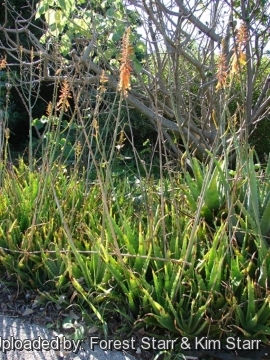 Flowers and fruit at Makawao, Maui, Hawaii (USA). December 11, 2006. Photo by: Forest Starr & Kim Starr
Flowers and fruit at Makawao, Maui, Hawaii (USA). December 11, 2006. Photo by: Forest Starr & Kim Starr Habit at Boneyard by seaplane hangar Sand Island, Midway Atoll, Hawaii (USA). June 11, 2008. Photo by: Forest Starr & Kim Starr
Habit at Boneyard by seaplane hangar Sand Island, Midway Atoll, Hawaii (USA). June 11, 2008. Photo by: Forest Starr & Kim Starr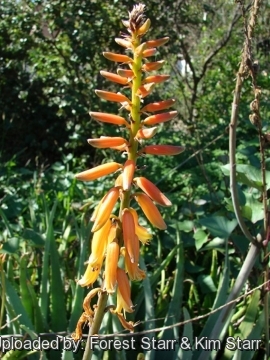 Flowers at Makawao, Maui, Hawaii (USA). December 11, 2006. Photo by: Forest Starr & Kim Starr
Flowers at Makawao, Maui, Hawaii (USA). December 11, 2006. Photo by: Forest Starr & Kim Starr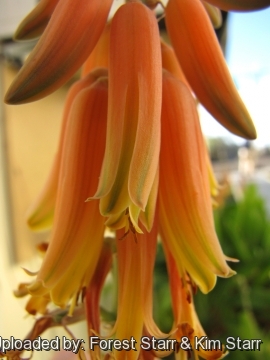 Flowers at Honokanaia, Kahoolawe, Hawaii (USA). December 22, 2009. Photo by: Forest Starr & Kim Starr
Flowers at Honokanaia, Kahoolawe, Hawaii (USA). December 22, 2009. Photo by: Forest Starr & Kim Starr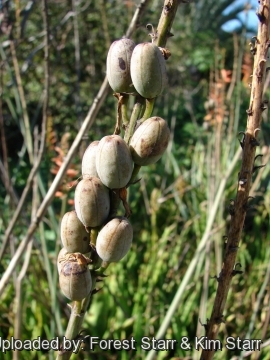 Fruit at Makawao, Maui, Hawaii (USA). December 11, 2006. Photo by: Forest Starr & Kim Starr
Fruit at Makawao, Maui, Hawaii (USA). December 11, 2006. Photo by: Forest Starr & Kim Starr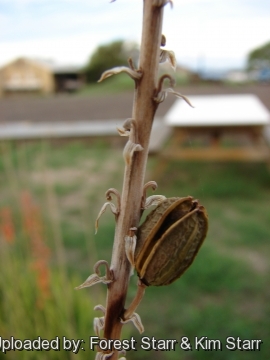 Seedpods at Honokanaia, Kahoolawe, Hawaii (USA). December 30, 2008. Photo by: Forest Starr & Kim Starr
Seedpods at Honokanaia, Kahoolawe, Hawaii (USA). December 30, 2008. Photo by: Forest Starr & Kim Starr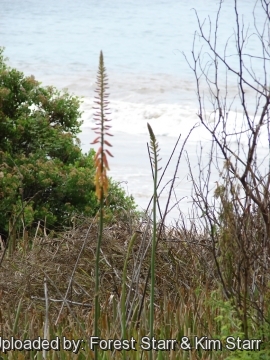 Flower stalk at Kamaole Point Kihei, Maui, Hawaii (USA). October 17, 2006. Photo by: Forest Starr & Kim Starr
Flower stalk at Kamaole Point Kihei, Maui, Hawaii (USA). October 17, 2006. Photo by: Forest Starr & Kim Starr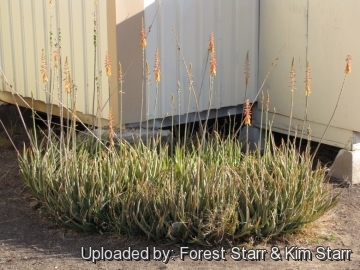 Flowering habit at Honokanaia, Kahoolawe, Hawaii (USA). December 18, 2012. Photo by: Forest Starr & Kim Starr
Flowering habit at Honokanaia, Kahoolawe, Hawaii (USA). December 18, 2012. Photo by: Forest Starr & Kim StarrCultivation and Propagation: Aloe massawanaSN|29242]]SN|29242]] is a resistant plant that tolerates poor soil and drought, but requires excellent drainage and usually does not give many problems in cultivation. It is a particularly fast-growing, tough and adaptable species. It is also very tolerant of extreme coastal and beach exposure, as well as salt spray. This is one of the most salt tolerant aloes! It is a profusely suckering species, and one plant can eventually cover a large area. The plant in itself is very tough and can survive often for several seasons without water, at which point the leaves turn a reddish colour, a sign generally associated with stress.
Exposition: Needs bright sunny conditions but enjoy some shade in summer.
Waterings: It needs abundant irrigation at time of growth.
Hardiness:** The plants favour mild to hot summers. They cannot resist cold weather and even an occasional frosts produce wounds and burns that disfigure their aspect.
Soil: Grow it in light or sandy, fertile, well-drained, soils, with a slightly acidic pH (5-6).
Uses: Plant in rock gardens and flower pots. Also suitable for coastal planting.
Maintenance: Removal of old flower stalks; Divide the crowded clumps periodically. During the winter months it may become dormant, during which little moisture is required. In areas that receive frost or snow the species is best kept indoors or in heated glasshouses.
Propagation:*** By division of offshoots that develop around the outside of the main rosette in spring. The best results are achieved by simply making stem cuttings. Allow cuttings to dry for a few days and insert into river sand and keep moist. The roots appear after about two weeks.


















